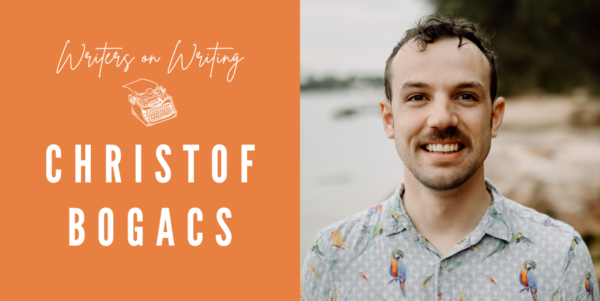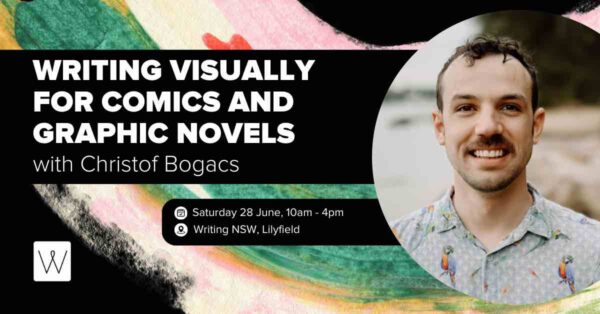
Writers on Writing is our regular conversation with a writer or industry professional about the writing craft, industry insights, and their own practice. This week, we spoke to Christof Bogacs about how you don’t need to be a visual artist to write comic scripts and the fluidity between words and different visual forms.
Does a writer need to be a skilled visual artist to write for comics or graphic novels?
Not at all!
While you need to be a skilled artist if you want to draw your own comics, when working the American way, the writer is responsible for creating the comic script. This script is a purely written document, with occasional reference images.
The core skill of a comic writer is to think visually and understand what information an artist needs to create an image. Scripting involves describing images, sometimes very specific ones. The good news is that you can use reference images in your scripts, which I do a lot.
Basically, as long as you can communicate the important parts of your visuals to your artistic collaborators, you’re golden.
In your debut graphic novel, Under Kingdom, Marie Enger’s art has a distinct style that matches your storytelling. What should an author consider when thinking about what visual style matches their story?
I was lucky to have been able to build Under Kingdom from the ground up with Marie. I came to them with a rough logline and we went back and forth from there, bouncing ideas and influences. Marie also had a bunch of cool monster designs they had drawn previously that I was able to bring into the story.
Working like this, with an artist attached from conception, is the ideal. However, a lot of the time, particularly if you are just starting out, you don’t have this luxury.
I think the biggest thing writers can do when creating a script is assemble a mood board of images that reflect the feel of the story. These could be from comics, film, tv, or just evocative pieces of art. Whatever communicates the visual language of the book.
When you do find an artist, encourage them to add to the moodboard. This is a great way to make sure you are both on the same page visually.
It’s also important that writers are flexible. Comics are a highly collaborative medium. When you bring a script to an artist you need to be open to changing things based on their feedback. The purpose of a good comic script is to disappear completely!
When writing a comic script, how clear and defined should a writer’s vision for the art be?
This one’s a little tricky to answer directly….
Basically, comics are all about compression. A lot of the time you’re figuring out the absolute bare minimum you need visually for a story to work. Sometimes this is just an emotion, other times you might want a really specific image.
It changes pretty dramatically based on the purpose of the panel. Sometimes my panel descriptions will be a few paragraphs. Other times they’re just a few words.
I guess what I’m trying to say is that the core of your vision needs to be incredibly defined, while leaving ample space for negotiation, evolution and growth. Frankly, it can be an incredibly hard target to hit.
Writing a comic script seems to require a completely different skill set compared to writing fiction novels. How similar or different are these two forms of writing?
Honestly, I would say they have very little in common. This comes as a surprise to a lot of people.
Compared to comics, prose gives you an incredible amount of time to delve into a character’s inner world and perspective. You just don’t have the time to do this in comics.
In terms of written forms, comics have the most in common with poetry. I find people with experience in poetry tend to take to comics the quickest. Both forms share an emphasis on minimalism and efficiency evoking emotion. There’s also a shared reliance on very direct visual writing.
Comics also have a bunch of elements in common with screenwriting; however, there’s danger in conflating the two since one involves describing moving images and the other static images.
What advice would you give to a writer who wants to begin writing visually, but isn’t sure where to start?
I think one of the best things you can do is pick a comic page, or even a single image, and describe it in words. The aim here is to create a written prompt a visual artist could use to make the image (or one similar) to the one you’re looking at.
This exercise forces you to think about key details and the core function of an image. You’ll strip away the unimportant details, honing in on the visual features needed to communicate the idea.
That’s really the heart of visual writing; you want to achieve this fluidity between words and different visual forms that allows you to go back and forth with ease. It’s about discovering your way of accessing the universal visual language.
I also highly recommend reading Understanding Comics by Scott Mcloud. It’s a dense read, but it really is the bible of making comics. I try to re-read it every few years.
Christof Bogacs (He/They) is a non-binary comic writer from Sydney, Australia. His debut graphic novel Under Kingdom, a middle grade fantasy-comedy with an emphasis on non-violent problem solving, was released in April 2023 through Dark Horse Comics. It was listed by The Mary Sue as one of the best Graphic Novels of 2023. Rick and Morty presents: Brawlher, his first licensed work, was published by Oni Press in April, 2024. This was followed by the Rick and Morty New Year Special published in January of 2025. His short comics have been published by Image Comics and in the Ringo Award Nominated ‘Dead Beats’ anthology from AWBW as well as the Eisner award winning ‘PanelXPanel’ magazine. He is represented by Jessica Mileo at Inkwell Management (NYC) a leading agency for comic book creators.
Join Christof Bogacs’s course, Writing Visually for Comics and Graphic Novels, Saturday 28 June 2025, 10am-4pm at Writing NSW.
If you want to be the first to read great advice, prompts and inspiration from our incredible tutors, subscribe to our weekly e-newsletter Newsbite.
More from Writing NSW
Check out our full range of writing courses in Sydney, our online writing courses and our feedback programs to see how we can help you on your creative writing journey. Find out about our competitions and opportunities, as well as writing groups across NSW, and sign up to our weekly newsletter for writing events, opportunities and giveaways.

